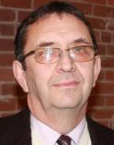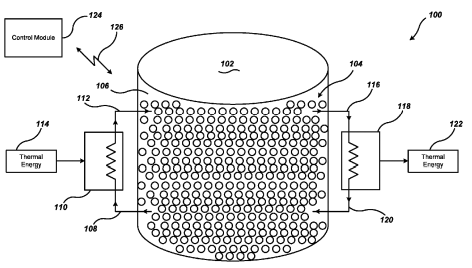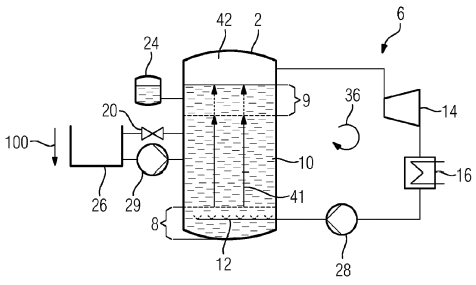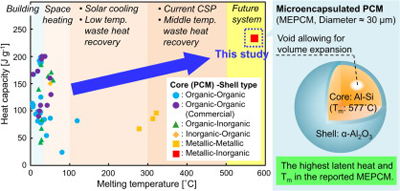 The Phase Change Matters e-mail newsletter is a weekly summary of the latest news and research on phase change materials and thermal energy storage. To subscribe, visit www.puretemp.com/subscribe. For more frequent updates, follow @puretemp on Twitter or visit the Phase Change Matters blog, www.puretemp.com/pcmatters.
The Phase Change Matters e-mail newsletter is a weekly summary of the latest news and research on phase change materials and thermal energy storage. To subscribe, visit www.puretemp.com/subscribe. For more frequent updates, follow @puretemp on Twitter or visit the Phase Change Matters blog, www.puretemp.com/pcmatters.
PHASE CHANGE MATERIALS
U.S. manufacturers agree to work together to form PCM association
Representatives of Phase Change Energy Solutions, Insolcorp Inc., Entropy Solutions and other companies attending a thermal mass workshop in Florida this week agreed to work together to form a North American PCM manufacturers association.
 Thermal Mass Workshop V, organized by Dr. Jan Kosny of the Fraunhofer Center for Sustainable Energy Systems, was a fitting venue for the preliminary discussion. PCMs have been a focus of the workshop since it was first held in 2001. On Sunday afternoon, after more than eight hours of presentations on the microencapsulation of inorganic PCMs, thermal performance of PCMs in roofing and walls, PCM testing standards and methods, whole building PCM modeling and other topics of interest to the industry, workshop participants turned their attention to the day’s most important topic.
Thermal Mass Workshop V, organized by Dr. Jan Kosny of the Fraunhofer Center for Sustainable Energy Systems, was a fitting venue for the preliminary discussion. PCMs have been a focus of the workshop since it was first held in 2001. On Sunday afternoon, after more than eight hours of presentations on the microencapsulation of inorganic PCMs, thermal performance of PCMs in roofing and walls, PCM testing standards and methods, whole building PCM modeling and other topics of interest to the industry, workshop participants turned their attention to the day’s most important topic.
The discussion of an association, scheduled in advance, didn’t go as deep as some participants had expected. At the outset, representatives of all manufacturers present agreed in principle to work together to further mutual interests. They talked briefly about the need for such an association to establish PCM performance standards; to work to get PCMs recognized in building standards and codes; and to educate developers, regulators, building product manufacturers and the public about PCMs. They talked briefly about structure and bylaws. And they talked briefly about membership eligibility, including associate and affiliate memberships for researchers, government officials and manufacturers of building products.
A full discussion of these topics and more will take place at a meeting in Boston in six months, with the goal of formally establishing an association in 12 months. Kosny invited workshop participants to send comments on association objectives to jkosny@cse.fraunhofer.org. He suggested that monthly conference calls and online discussions be established to help draft a structure for the first meeting. A date, venue and agenda will likely be posted early next year.
“The market is big for these materials,” Kosny said afterward. “If the industry works together, then we are much, much stronger.”
BUILDING MATERIALS
PCM, foam insulation combine to reduce heat transfer through walls
Researchers at the Fraunhofer Institute for Chemical Technology in Germany say they have successfully integrated phase change material in foam insulation for use in walls.
What’s new about the technology?
“Instead of a few micrograms, several grams of the phase change materials have been integrated. Therefore the thickness of the wall is not changing by increasing the thermal mass,” says Sandra Pappert, a scientist at Fraunhofer.
Details of the research will be presented at the BAU trade fair in Munich, Jan. 16-21, 2017. Researchers will use two climatic chambers to demonstrate the extent to which the foam sheets can help manage temperature fluctuations in buildings.PATENTS

Thermal energy storage system comprising encapsulated PCM
U.S. patent application 20160356554 (applicant Terrafore Technologies, Minneapolis, Minn., and Southwest Research Institute, San Antonio, Texas):
“Systems for storing and retrieving thermal energy in encapsulated phase change material are disclosed. Thermal energy is substantially stored and/or retrieved in the form of latent heat. The capsules comprise an outer shell which is impervious to both the heat transfer fluid within which they are submerged and the phase change material encapsulated therewithin. Methods for encapsulating the phase change material are also disclosed.”
HVAC systems for electrically powered vehicles
U.S. patent application 20160355068 (applicant BorgWarner Inc., Auburn Hills, Mich.):
“A heating, ventilation, and air-conditioning (HVAC) system for an electrically-powered vehicle (EV) having an electric motor powered by at least one battery, comprising: a blower; a conduit configured to carry air from the blower to vents leading to a passenger cabin of the EV; an electric heater positioned in the conduit and configured to heat the air; and a thermal reservoir heater positioned in the conduit and including a second electric heater powered by the battery and a phase change material (PCM) in heat exchange relation to the second electric heater and the air, the PCM surrounding the second electric heater and being configured to absorb and store heat from the second electric heater, the PCM being further configured to release heat into the air without using power from the battery.”
Method and device for discharging a stratified thermal storage tank
U.S. patent application 20160356553 (Siemens AG, Munich, Germany):
“A method and a device for discharging a thermal stratification storage tank are provided, wherein a first thermal stratification storage tank has a first temperature in a first subsection and a second temperature in a second subsection, when the working fluid of an organic Rankine cycle in the liquid aggregate state in a fluid heat transfer medium of the first thermal stratification storage tank is introduced into the first or second subsection and brought into direct material contact with the heat transfer medium, wherein at the second temperature in the second subsection the pressure in the first thermal stratification storage tank is less than or equal to the vapor pressure of the working fluid. … In one embodiment, a phase-change material is used in the stratified thermal storage tank for storing thermal energy.”

IN BRIEF
• An Australian company says it has successfully tested a prototype of a silicon-based thermal energy storage system. Latent Heat Storage, which is in the process of changing its name to 1414°, says the system is ready for commercialization at scales of 10 MWh and 200 MWh. Suitable demonstration sites, the company says, include wind farms and gas-fired generators.
• Registration is open for the Advancements in Thermal Management conference, to be held in Denver Aug. 9-10, 2017. Organizers have issued a call for papers; the deadline for submitting an abstract is Feb. 17. Companies attending past conferences include Croda, Outlast Technologies, Phase Change Materials Ltd., Microtek Laboratories, C-Therm Technologies and Entropy Solutions.
• Ice Energy of Glendale, Calif., is looking for distributors in Australia to extend the reach of the company’s ice-based energy storage systems. The Ice Bear and smaller Ice Cub store cooling energy by freezing water in an insulated tank. During peak hours, the company says, the stored ice delivers up to four hours of cooling, reducing the typical peak load by 95 percent.
• The use of phase change material in infant warming blankets (Embrace Innovations) and temperature-control fabrics (Outlast Technologies) is featured in NASA’s Spinoff 2017. The annual report highlights technologies developed for the space program.
• Tata Steel is integrating Energy Nest‘s thermal energy storage system into one of the steelmaker’s plants in the Netherlands. The system captures waste heat in a special concrete and stores it for later use.
• A new technical report issued by the National Renewable Energy Laboratory examines the possibility of replacing fossil-fuel combustion in industry with small nuclear reactors, solar thermal and geothermal energy sources to reduce greenhouse gas emissions. “Phase change materials that exploit the relatively high energy involved in melting or freezing a material” are identified as among the thermal energy storage options critical to such a strategy. Related: “Changing the Game by Linking Nuclear and Renewable Energy Systems.“
• Google has confirmed it will hit its target of offsetting 100 percent of the energy used at its data centers and offices with power from renewable sources in 2017. LinkedIn, meanwhile, has opened what it describes as its first “net zero energy” building at its campus in Sunnyvale, Calif.
• The International Union of Pure and Applied Chemistry has officially named four new super-heavy elements — nihonium (Nh), moscovium (Mc), tennessine (Ts), and oganesson (Og) — and added them to the periodic table. The lab-created elements have atomic numbers of 113, 115, 117 and 118, respectively.
RESEARCH ROUNDUP
For our full list of recent academic research, see puretemp.com/academic. Here are highlights from the past week:
From International High-Performance Built Environment Conference:• Thermal energy storage enhancement of lightweight cement mortars with the application of phase change materials
From Dublin Institute of Technology:
• Mechanical and Thermal Evaluation of Different Types of PCM-concrete composite panels
From Energy and Buildings:
• Thermophysical properties of n-tetradecane@polystyrene-silica composite nanoencapsulated phase change material slurry for cold energy storage
From Energy Conversion and Management:
• Microencapsulated phase change materials for enhancing the thermal performance of Portland cement concrete and geopolymer concrete for passive building applications
From Solar Energy Materials and Solar Cells:
• Thermal energy storage characteristics of poly(styrene-co-maleic anhydride)-graft-PEG as polymeric solid–solid phase change materials
• Natural magnetite for thermal energy storage: Excellent thermophysical properties, reversible latent heat transition and controlled thermal conductivity
From Applied Energy:

• Microencapsulated phase change materials with high heat capacity and high cyclic durability for high-temperature thermal energy storage and transportation
From Renewable Energy:
• Thermal analysis of molten ternary lithium-sodium-potassium nitrates
From Renewable and Sustainable Energy Reviews:
• A critical review of eutectic salt property prediction for latent heat energy storage systems
• Review on system and materials requirements for high temperature thermal energy storage. Part 1: General requirements
From International Journal of Refrigeration:
• An apparatus to measure the thermal conductivity of insulation panels at sub-ambient temperature
NETWORKING
Connect with PCM experts and industry leaders on LinkedIn
More than 950 of your peers have joined a LinkedIn group devoted to the discussion of phase change material and thermal energy storage. The Phase Change Matters group is an interactive complement to the award-winning blog and newsletter of the same name.
You are invited to join the group and connect with PCM and TES experts from around the world. New members this week include Frederyk Ngantung, director of business development at Elevance Renewable Sciences, Chicago; Mustafa Koz, postdoctoral research associate at Syracuse University, New York; Alicia Oliver Ramírez, project manager at Nuevo Arpegio, Spain; and Ying Liu, founder at ReinEsse, Hartford, Conn.